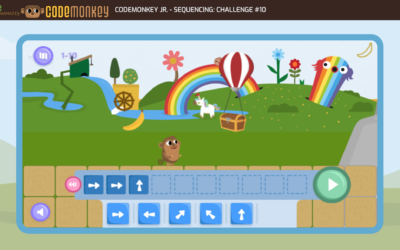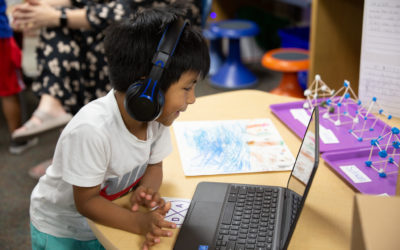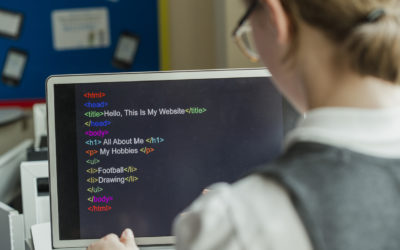Computational thinking has become important to teaching problem solving in education because it empowers students with processes to develop strategic solutions to complex problems, essentially “leveling up” their skills, or creating algorithms that can make future processes more effective. This enables students to take on more complex challenges and prepare for real-world applications.
Decomposition in Computational Thinking
While the process of computational thinking is multifaceted, there is one key to computational thinking that is essential for success: decomposition. Decomposition is the process of breaking a complex task or problem into smaller, more manageable pieces. From this decomposition, students can eliminate unnecessary information, identify patterns and begin the process of identifying which parts of the problem are most important, how to solve or complete each step, and how those parts can be put together for a clear and unified step-by-step solution.
Why is the Decomposition Technique Required in Computational Thinking?
The technique of decomposition is required in computational thinking because it breaks complex tasks into subtasks while developing a sequentially-based understanding of the problem. This allows unnecessary information to be discarded, patterns to be identified, relevant information to be extracted and the process of step-by-step resolution to be defined for a more effective problem-solving process.
By definition, computational thinking is the process of tackling complex problems and finding a clear, step-by-step solution that can be replicated. Decomposition, therefore, is essential to this process as it includes breaking a task into several sub-tasks, helping to align the task to a step-by-step solution.
Another reason decomposition in computational thinking is important is because it allows each subtask to be examined more closely. This not only helps to categorize information as essential or non-essential, but also empowers the problem-solver with a better ability to analyze each specific part of the task or challenge to more effectively develop a reasonable solution.
Examples of Decomposition in Computational Thinking
Below are some real-world examples of utilizing decomposition in computational thinking:
- You have to clean your house. Instead of facing the task as a whole, you practice decomposition by breaking the task into a to-do list with multiple subtasks.
- To build shelves for a storage space, you practice decomposition by measuring the space, creating a blueprint or plan to determine the size of the shelves and the materials you need to accomplish the task. Next, you purchase the supplies and cut the lumber to size, then install one wall of shelves at a time.
- In science, to prove or disprove a hypothesis, you practice decomposition by creating subtasks including background research, observation, generating a hypothesis, determining which variables to test, performing experiments and drawing a conclusion.
Final Thoughts
Consider how often computational thinking appears in your everyday life. Do you naturally use decomposition and computational thinking to resolve a challenge? For more information about computational thinking and how they apply to students, explore some of our most recent articles:
Tips for Parents to Keep Kids Safe Online
As a parent, and someone who works for a digital literacy company, I’ve been thinking lately about how scary it can be to raise young children in our evolving educational landscape. My son is entering kindergarten this year (cue the tears!) and my daughter is 19...
Computer Science Isn’t What You Think
Last week, I was honored to be among over 500 leaders of corporate and non-profit organizations signing a letter to governors and education leaders across the United States. This letter calls for an important shift in our K-12 curriculum across the nation, allowing...
Coding Skills for Kids for a Successful K-8 Coding Program
It’s becoming common to teach age-appropriate coding skills to kids at school through computer classes. Not only do these programs provide career-ready skills for the future, but they also introduce concepts and techniques that can be utilized in a variety of...
Why is Media Literacy in Education Important?
Frank Baker is a TV journalist turned district administrator turned researcher, writer, and professional development facilitator. Across the diverse positions he’s held, Frank’s work is inspired by his commitment to educating teachers and students to be informed and...
How to Promote Digital Citizenship in Students
As students spend more and more time online, digital citizenship is becoming increasingly important for students to master. In this article, we discuss techniques and hands-on exercises for promoting digital citizenship in students. What is Digital Citizenship?...
Fontana Unified School District Bridges Digital Skills Gaps with EasyTech
Fontana Unified School District serves a fast-growing suburban community 50 miles east of Los Angeles. Although they began piloting Learning.com's EasyTech before 2020, the sudden shift to remote learning during the pandemic highlighted the gaps in students’ digital...
Learning.com’s Guide to ISTELive 22
Are you attending ISTELive 22 next week? Well, we’re ready for you! After a 2-year Covid-related hiatus, ISTE is bringing back their annual event live and in-person in the host city of New Orleans. From the speakers to the events and activities, tech educators will be...
Examples of Computational Thinking in the Classroom
If you are looking for examples of computational thinking projects to do with students, then you have come to the right place. Though computational thinking is often associated with computer science, its process guides problem solving across a variety of different...
Tulsa Public Schools Enhance Digital Skills with EasyTech
When Tulsa Public Schools’ manager of library services Vicki Ruzicka first implemented Learning.com’s EasyTech in 2018, it was primarily to meet federal requirements for online safety lessons for students. But as the program gained traction – not only in the libraries...
Definitions of Computational Thinking, Algorithmic Thinking & Design Thinking
There are a lot of ways to think about problem solving. This article will take on the three of these that we are recently hearing more about: computational thinking, algorithmic thinking and design thinking. While there are differences between each, these methods all...
12 Rules for Protecting Students Online
Schools that have computer resources such as a computer lab or library open to students have rules and requirements to keep children safe online. The Children's Internet Protection Act (CIPA) is a Federal law enacted by Congress to help protect children’s access to...
How do Students Learn to Code?
Parents and teachers are recognizing the importance of teaching students to code. Not only does coding help empower students with career skills, but it also helps to develop creative thinking, problem-solving, perseverance and more. However, because coding is a...

Learning.com Team
Staff Writers
Founded in 1999, Learning.com provides educators with solutions to prepare their students with critical digital skills. Our web-based curriculum for grades K-12 engages students as they learn keyboarding, online safety, applied productivity tools, computational thinking, coding and more.













